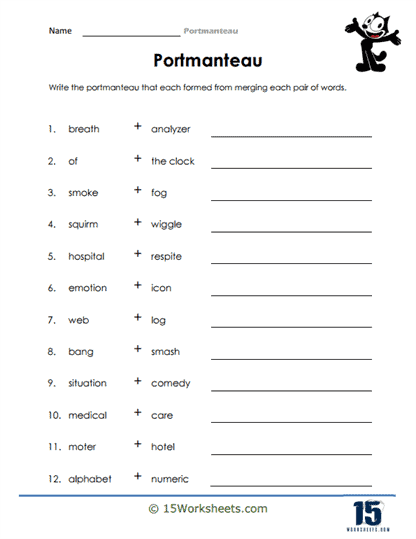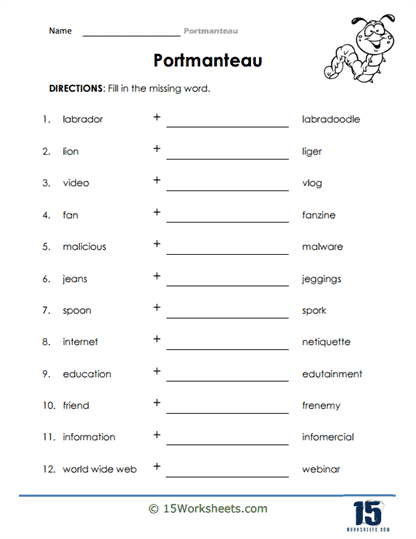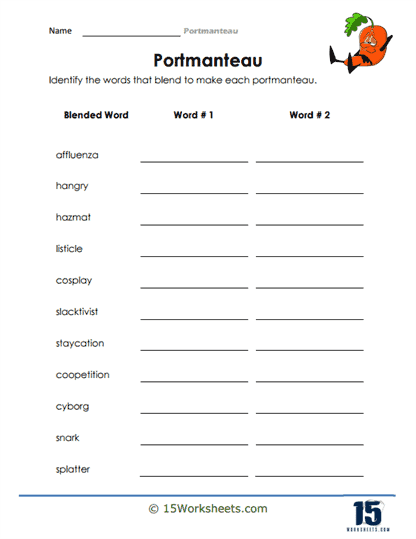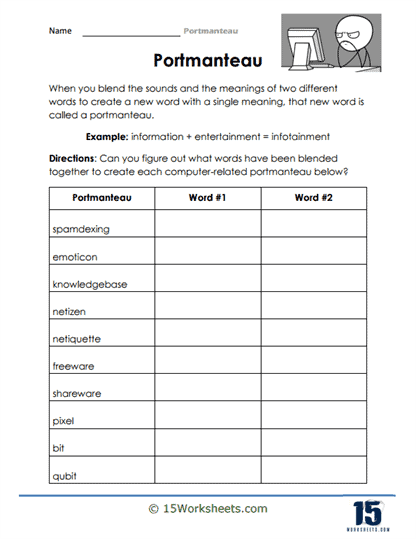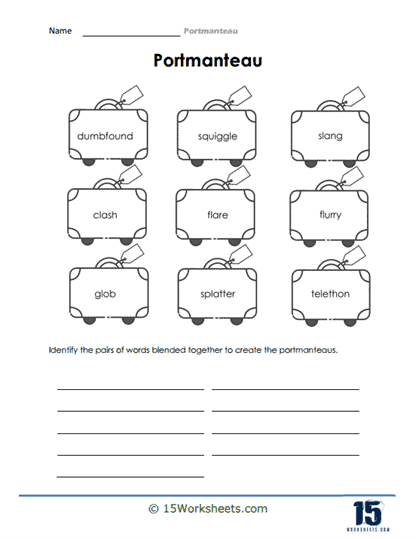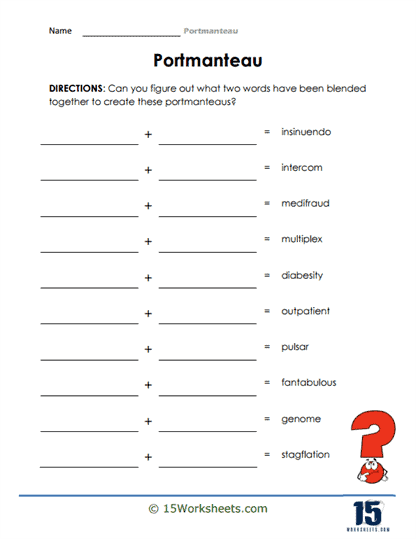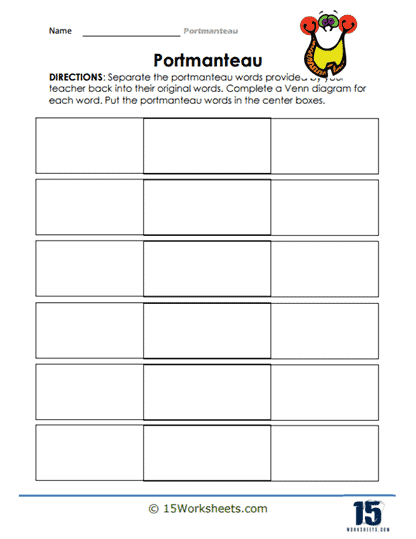Portmanteau Worksheets
About These 15 Worksheets
These worksheets were prepared to enhance students’ understanding and creativity in language arts by exploring portmanteaus. A portmanteau is a word that merges the sounds and meanings of two different words, like “brunch” (breakfast + lunch) or “smog” (smoke + fog). These worksheets introduce learners to the concept of portmanteaus, guide them through the process of identifying and creating them, and ultimately help improve their language arts and reading skills. Below, we will explore the various exercises found on portmanteau worksheets, their educational benefits, and how they contribute to a deeper understanding of language.
Through a range of exercises, these worksheets not only teach students about an interesting linguistic phenomenon but also foster a deeper appreciation and understanding of language’s creative potential. Engaging with portmanteaus helps students recognize the flexibility of language, encouraging them to explore and experiment with new word combinations. Ultimately, practicing with portmanteau worksheets prepares students to approach language with curiosity, creativity, and a deeper understanding of its evolving nature.
Types of Exercises
Portmanteau worksheets comprise a variety of exercises tailored to different learning objectives. These exercises can include:
Identification – Learners are given a list of portmanteaus and their definitions to match them with their component words. This exercise helps students recognize portmanteaus in written text and understand their meanings.
Creation – Students are provided with pairs of words and asked to combine them into new portmanteaus. This activity encourages creativity and understanding of how words can be blended.
Matching – These exercises involve matching portmanteaus with their correct definitions or images, which aids in vocabulary building and comprehension of the words’ meanings.
Usage – Students are tasked with using portmanteaus in sentences or short paragraphs. This helps in understanding how portmanteaus can be utilized contextually within the language.
Analysis – In these exercises, students analyze how portmanteaus affect the tone and meaning of sentences or passages. This develops critical thinking and analytical skills. Learners search through provided texts to find and identify portmanteaus, fostering attention to detail and enhancing reading comprehension skills.
Creative Writing – Students use a list of portmanteaus to write a story or poem. This not only bolsters creative expression but also integrates the use of portmanteaus into broader language skills.
Decomposition – Here, students are given portmanteaus and asked to identify the two original words. This reinforces understanding of how portmanteaus are formed.
The Benefits of These Worksheets
Practicing with portmanteau worksheets offers numerous educational benefits, crucial for the development of language arts and reading skills:
Enhanced Vocabulary – Students learn new words and understand the creative process of word formation, expanding their vocabulary. By creating their portmanteaus, students explore the playful side of language, enhancing their creative writing skills and encouraging innovative thinking.
Improved Reading Comprehension – Identification and usage exercises help students become more adept at understanding context clues, thereby improving reading comprehension. Analyzing and working with portmanteaus heightens students’ awareness of language nuances, including how words can evolve and blend over time. Exercises that require analysis of portmanteaus’ effects on text or creating stories using portmanteaus develop critical thinking and analytical skills.
Attention to Detail – Discovery exercises cultivate a meticulous approach to reading, training students to pay close attention to the details of the text. Through portmanteaus, students grasp the dynamic nature of language and how it adapts to cultural and societal changes.
What is the Literary Device of Portmanteau?
The literary device of portmanteau is a fascinating and creative tool in the domain of language and literature, blending both sounds and meanings of two distinct words to create a new one. This technique is not just about wordplay; it serves deeper purposes in writing, such as enriching the text with new layers of meaning, enhancing its aesthetic quality, or introducing innovative concepts that standard vocabulary may not fully capture. The essence of a portmanteau lies in its ability to convey complex ideas or descriptions succinctly and inventively, offering authors a unique method to expand the expressive capacity of language.
The Defining Features of a Portmanteau
The primary defining feature of a portmanteau is its formation by merging parts of two (or occasionally more) separate words to produce a single new term that inherits semantic elements from each original word. This blending process involves both phonetic and semantic fusion, where not only the sounds but also the meanings of the original words are combined to create a word with a new, distinct identity that carries traits of both parents.
Characteristics of a Portmanteau
Several key characteristics distinguish portmanteaus from other word formations:
Semantic Combination – A portmanteau blends the meanings of its constituent words, resulting in a new word that encapsulates a concept or entity related to both originals.
Phonetic Fusion – It involves a blending of sounds from the original words, which often results in a term that is phonetically cohesive and pleasing to the ear.
Inventiveness – Portmanteaus are inherently creative, showcasing the playful and inventive side of language.
Economy of Language – They enable concise expression of complex or multifaceted ideas within a single word, enhancing the text’s efficiency.
Cultural and Contextual Flexibility – Portmanteaus often reflect cultural trends, technological advancements, or societal changes, making them highly context-sensitive.
Examples of Portmanteau in Literature
“Brave New World” by Aldous Huxley – “Somatotonic” – Derived from “soma,” referring to the body, and “tonic,” suggesting stimulation, “somatotonic” describes a substance in Huxley’s dystopian society that enhances physical performance and mood. This portmanteau encapsulates the novel’s theme of control through pharmacological means, highlighting the artificial enhancement of human conditions to maintain societal order. It succinctly conveys the dual action of the substance – both bodily and stimulating – reflecting the novel’s critique of dependency on technology and drugs for happiness and stability.
“Through the Looking-Glass” by Lewis Carroll – “Chortle” – Carroll is renowned for his creative use of language, and “chortle” is a blend of “chuckle” and “snort This portmanteau evokes a sense of amusement and delight beyond what either word could achieve alone, embodying the whimsical and nonsensical world Carroll creates. It enhances the imaginative quality of his work, inviting readers into a playful universe where language mirrors the unpredictability and inventiveness of the characters and their adventures.
“1984” by George Orwell – “Newspeak” – Combining “news” and “speak,” Orwell crafts a term for the deliberately restrictive and reductive language designed by the totalitarian regime in his novel to limit free thought and control the populace. “Newspeak” embodies the power of language as a tool for manipulation and oppression, encapsulating a key theme of the novel – the capacity for language to both liberate and constrain thought. The portmanteau serves as a stark warning against the dangers of linguistic manipulation by authoritarian powers.
The Effect of Portmanteau on the Reader
The use of portmanteaus in literature has a profound effect on readers, influencing their engagement with the text in several ways:
Cognitive Engagement – Portmanteaus stimulate readers’ curiosity and creativity, encouraging them to decipher the meaning and origins of these blended words. This engagement deepens their involvement with the text and enhances their appreciation of the author’s inventiveness.
Enhanced Imagery and Conceptualization – By condensing complex ideas or descriptions into a single word, portmanteaus can create vivid imagery or introduce novel concepts that enrich the reader’s imagination and understanding of the narrative.
Emotional and Aesthetic Pleasure – The novelty and playfulness of portmanteaus contribute to the aesthetic enjoyment of the text, often evoking pleasure or amusement through their clever construction and sound.
Reflective Insight – Portmanteaus can prompt readers to reflect on the themes and ideas presented in the text, as these words often encapsulate key aspects of the narrative or the author’s worldview. This reflective process can lead to a deeper understanding of the text’s underlying messages.

